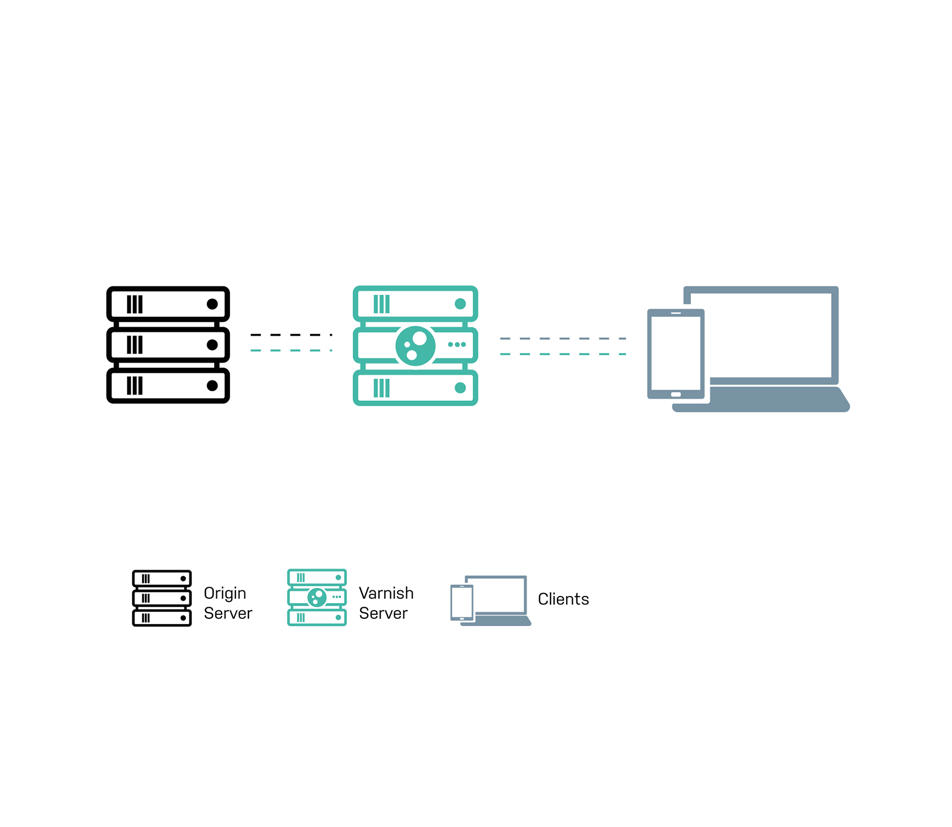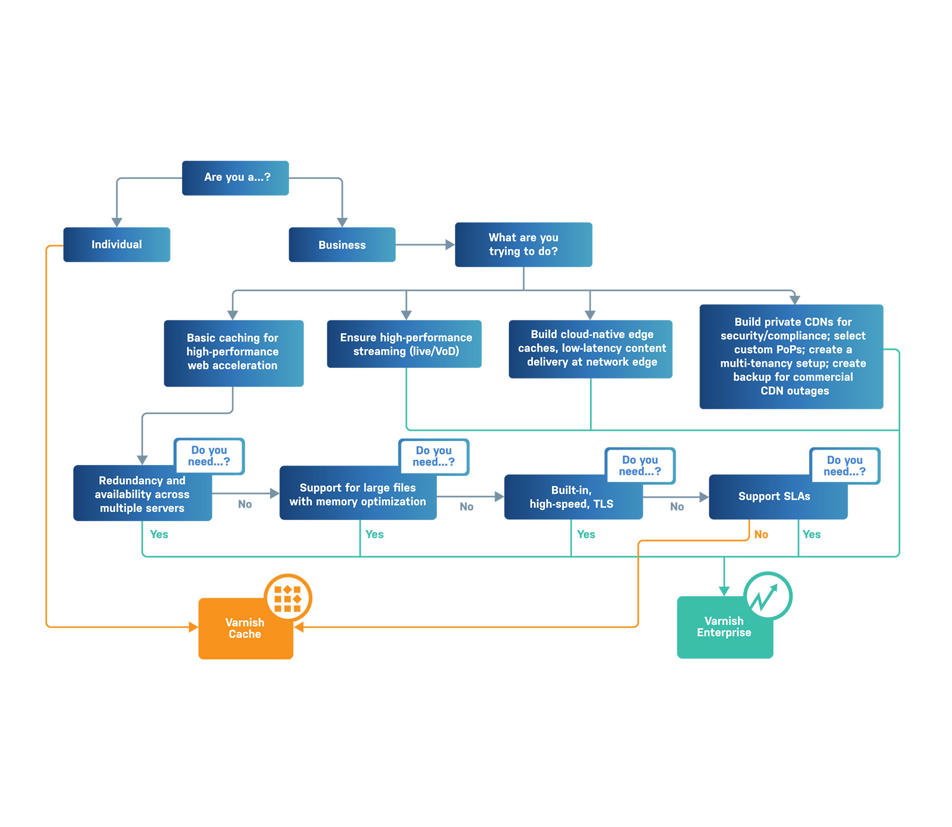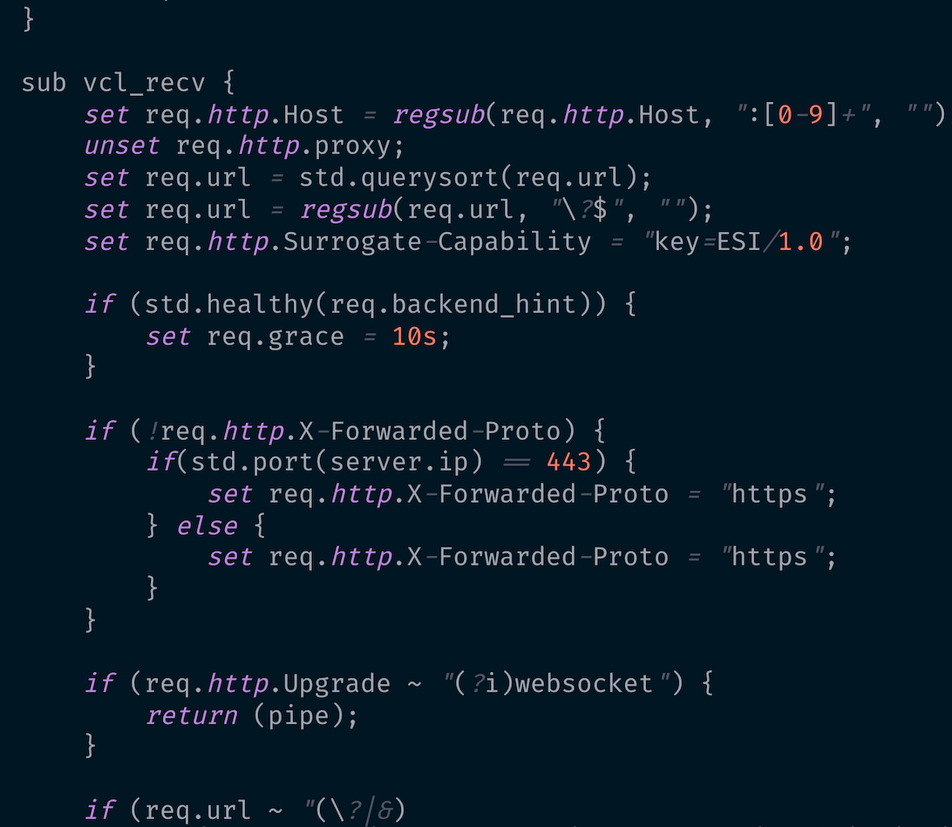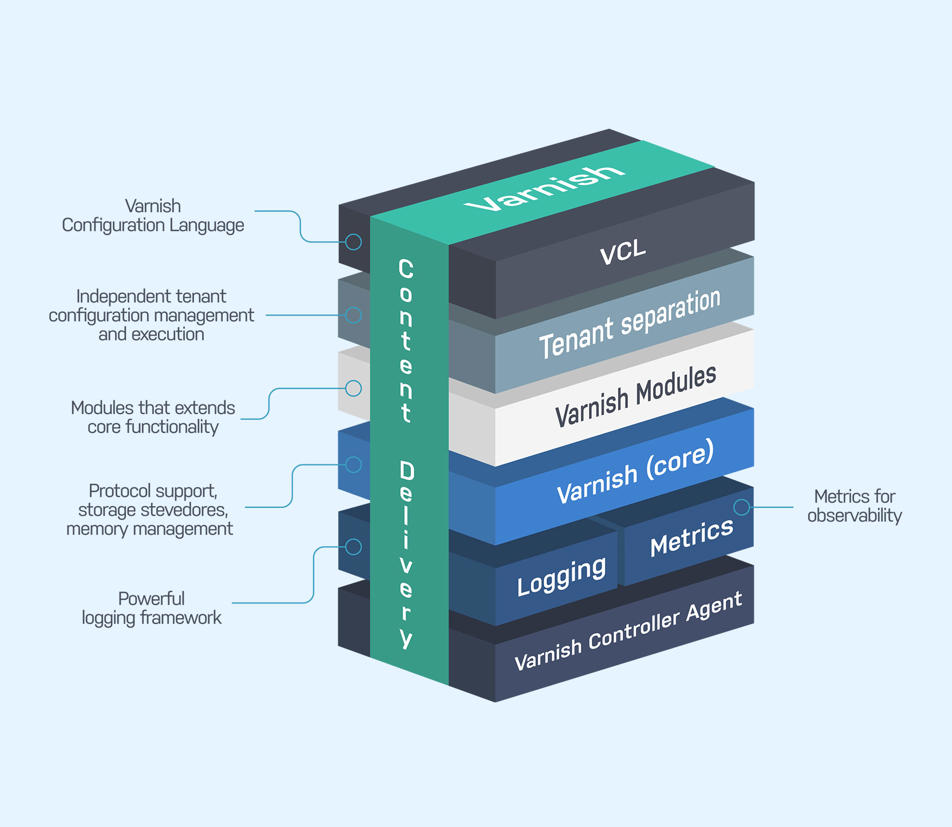VARNISH ENTERPRISE
Life Without Latency
Edge caching and content delivery software that unlocks fast, reliable digital experiences for users and systems.

Varnish Enterprise
Innovate, Accelerate
Varnish Enterprise is software that makes it easy to accelerate digital interactions, handle more traffic, protect infrastructure and reduce costs.
It deploys anywhere, on any platform, and is adaptable to every content delivery challenge that needs more power at the edge.
Most importantly, Varnish Enterprise gives back control over how, when and where digital content gets delivered.

Seamless Delivery from Origin to Edge
Blazingly Fast Interactions
Varnish Enterprise is extraordinarily capable.
Whether it’s web delivery, API acceleration, streaming, origin protection, application delivery or edge computing, Varnish delivers blazingly fast interactions and supports more traffic with fewer resources.
In terms of performance benchmarks, think:
< 1 ms cache responses
Over 1 Tbps video throughput per edge server
10x reduction in backend load

Massive Storage Engine
Cost-Effective Cache Persistence and Resilience
Massive Storage Engine (MSE) is powerful object storage that is fully integrated with Varnish Enterprise. It combines the speed of memory with the persistence of disk, with integrity checks and error handling to help prevent and mitigate downtime.
MSE is ideal for ensuring optimal caching of large data sets, like video, metadata and DevOps artifacts.
Cache persistence. Caches survive restarts. Avoid time-consuming cache reloads, enable greater speed and reliability.
Increased cache hits. A fair eviction strategy automatically evicts the least-accessed objects when required, while minimizing competition for storage.
Faster object retrieval. Fragmentation-proof allocation means each object is stored in one place.
Better disaster recovery. Distribute caches across different storage devices or warm caches separately before mounting them with hot data.

How We Help
Varnish Enterprise goes beyond simple caching to deliver:

Performance
Deliver HTTP content at low latency, high concurrency and high throughput for excellent user experiences, even during peak demand.

Stability
Reduce backend load and move workloads to the edge to protect the origin, save on egress and boost resilience.

Efficiency
Extract every bit of value from infrastructure and easily integrate with existing approaches.

Flexibility
Platform and content agnostic, with complete configurability to optimize HTTP delivery for any use cases.
"Varnish Enterprise makes my job a lot easier. We can manipulate Varnish Enterprise in ways that are not possible with other reverse proxies."
Michael Loftus
Senior Technology Infrastructure Engineer, RTÉ
Varnish Cache to Varnish Enterprise
Open-Source Born, Enterprise Raised
Built on top of the famous open-source reverse proxy Varnish Cache, Varnish Enterprise extends Varnish technology to enable enterprise-grade low-latency, high-throughput delivery.
Exceptional performance and features like disk caching, backend TLS, high availability and a UI are vital to mission-critical web services.
Migrating to Enterprise is a rewarding progression for growing web services, who get the performance and optimization they need to scale up cost-effectively.

Varnish Configuration Language
Run Edge Compute at Light Speed
Varnish Configuration Language (VCL) is Varnish’s secret weapon.
It's edge logic that runs inside Varnish and controls request handling, routing, caching, and more.
Apply logic to every HTTP transaction to ensure consistent experiences for end-users and maximum efficiency for caching operations.
VCL is very, very fast. Executing in microseconds, it gets transpiled to C instead of interpreted at runtime.

Who We Help
Across global industries, use cases and verticals, Varnish Enterprise is the software layer of choice for accelerating digital processes.
Features
Extensibility and Adaptability
Accelerate Everything HTTP
Varnish Enterprise is made up of a core caching engine, edge language, and a robust library of 45+ pluggable modules for enhancing and dialing in caching strategy. Varnish modules (VMODs) include:
- Content Localization
- Dynamic Load Balancing
- Content compression
- Key-based invalidation and purge
- Device and IP intelligence
- Edge-side page assembly
- Dynamic backends
- Advanced header and cookie manipulation
- JSON parsing and JWT verification
- Bot verification and request blocking
- Grace mode and soft purge
- Time to Live (TTL) controls
- Origin health checks
- And more!

The Full Varnish Enterprise Suite
The Varnish Enterprise suite includes the Controller, Traffic Router, and expert support to ensure deployment and delivery success.

Varnish Controller
UI-based management of Varnish instances and VCL for easy deployments and monitoring.

Varnish Traffic Router
Flexible HTTP request routing to ensure clients fetch content from the optimal cache.

The Software-Defined Edge
Effortless Orchestration
Deploy Varnish Anywhere. From public cloud and bare metal on-premise to Kubernetes clusters at the edge.
Custom Configuration. Deploy within your existing tech stack and integrate easily the tools you use every day.
Efficient Software Enables Scale. Content delivery is data intensive, and enterprises need more from less. Instead of adding hardware, Varnish delivers responsive digital interactions while reducing hardware needs.

Success Stories

Future Publishing
Varnish enables Future Publishing to achieve a robust and reliable caching layer for highly available content delivery across its media properties

Telia Company
Given the acquisition of TV4, MTV and CMore, Telia Company needed to re-evaluate their current CDN strategy and decided to build their "next generation" CDN together with Varnish as a key partner.

Intersport
Intersport is one of the world's leading sporting goods retailers. Their challenge was to adopt configurable, agile cache management to ensure accuracy and performance, implement initial line of defense against bot/DDoS attacks and improve user experience with faster page loads.
Support Plans
Varnish Enterprise subscriptions include software licensing and assistance from the Varnish Support and Engineering teams. Plans vary according to specific needs but the excellence and deep knowledge of our team stays the same. Choose the plan to suit your needs:
Standard Support
LEVEL OF SUPPORT
- Enterprise software license
- 20 support requests/year
- 8 hour max. response time
Premium Support
LEVEL OF SUPPORT
- Enterprise software license
- 24/7/365 support
- Unlimited support requests
- 2 hour max. response time
- 72 hour workaround SLAs

Varnish as a Managed Service
LEVEL OF SUPPORT
In addition to Premium
- 24/7 management by Varnish
- Dedicated Support Team
- Flexible SLAs
Varnish is Content Delivery Software
Deploy Content Delivery, Anywhere
While Varnish Enterprise is not a commercial CDN, many leading commercial CDNs are built on Varnish, and it’s the software of choice for building private and hybrid CDN services.
Varnish is about transforming digital platforms to unlock latency-free interactions at any scale.
It’s about putting the edge wherever you need it, and breaking free from the network to support vast numbers of transactions from fewer resources.

"If you have a million requests in one second then there is no time to scale. We needed a solution capable of delivering such a load at scale, and Varnish is it."
Max Reckers
Technology Lead, AFC Ajax
Connect with Our Team
We’re happy to help with any questions you may have about our software, support, pricing or anything else Varnish related. We can assist you in finding the solution that best fits your needs and set up trials too.

Talk to an Expert
- Varnish experts are available to answer your technical questions and help you find the solution you need.

Live chat
Talk with an advisor about the right solution for your needs


Message us
We have offices across the globe who can help answer any questions you may have.















